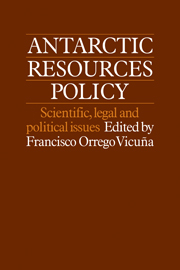Book contents
- Frontmatter
- Contents
- List of contributors
- 1 Antarctic resources policy: an introduction
- Part one The state of Antarctic knowledge and experience
- 2 Antarctica: its history and development
- 3 The living resources of the Southern Ocean: a scientific overview
- 4 The mineral resources of Antarctica: progress in their identification
- 5 Environmental factors in the development of Antarctica
- 6 Cooperation in the Antarctic: a quarter of a century's experience
- Part two The policy for the conservation of the living resources of Antarctica
- Part three The policy for the exploration and exploitation of the mineral resources of Antarctica
- Part four Issues on Antarctica and the law of the sea
- Part five The policy for Antarctic cooperation
4 - The mineral resources of Antarctica: progress in their identification
Published online by Cambridge University Press: 06 July 2010
- Frontmatter
- Contents
- List of contributors
- 1 Antarctic resources policy: an introduction
- Part one The state of Antarctic knowledge and experience
- 2 Antarctica: its history and development
- 3 The living resources of the Southern Ocean: a scientific overview
- 4 The mineral resources of Antarctica: progress in their identification
- 5 Environmental factors in the development of Antarctica
- 6 Cooperation in the Antarctic: a quarter of a century's experience
- Part two The policy for the conservation of the living resources of Antarctica
- Part three The policy for the exploration and exploitation of the mineral resources of Antarctica
- Part four Issues on Antarctica and the law of the sea
- Part five The policy for Antarctic cooperation
Summary
The increment in information
Careful geological investigations started at a few places in Antarctica after World War II, but gained momentum and became systematic only when the International Geophysical Year started, and when SCAR and its Working Group on Geology were established just 25 years ago. Although geology was not initially part of the IGY programme, it soon became one of the thriving sciences in Antarctica.
The growth of Antarctic geosciences can be shown in many ways, for example by the expansion of the Symposium volumes from the first one in 1963, containing 76 papers, to the latest one in August 1982, with 191 papers.
The investigations have largely had the character of regional reconnaissance surveys, and the observations have mostly been published as general descriptions with maps at the scale of 1:1 million or smaller. Only one Antarctic nation has a systematic mapping programme of larger scales (1:500,000). In a few cases, such as in areas around some larger stations, more detailed work has been going on, in some cases also related to mineral occurrences. A few programmes are under way that have aspects of being resource-oriented: investigations of the Dufek Massif, a layered intrusion similar to the Cr-, Pt- and Ni-rich Bushfeld complex in South Africa, and sampling of manganese nodules during marine geological surveys. Airborne radiometric surveys and also some marine seismic surveys conducted by national oil companies or by resource-oriented state agencies belong to this category.
- Type
- Chapter
- Information
- Antarctic Resources PolicyScientific, Legal and Political Issues, pp. 61 - 76Publisher: Cambridge University PressPrint publication year: 1983
- 7
- Cited by



